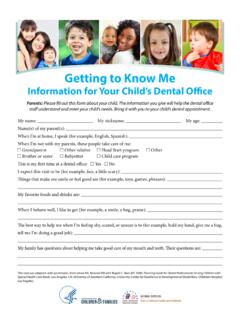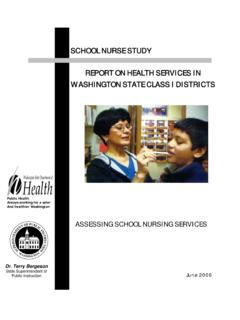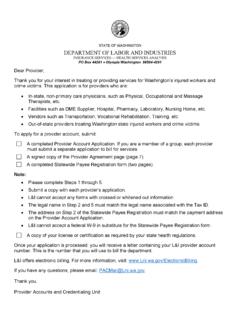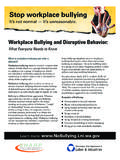Transcription of What You Should Know and How You Can Help
1 Dentists and Head StartWhat You Should know and How You Can HelpWhat Is Head Start?Head Start was established in 1965 to improve the school readiness of children ages 3 to 5 from families with low incomes. In 1994, Early Head Start was established to serve low-income pregnant women, with a focus on positive birth outcomes, and to promote healthy physical and cognitive development in children from birth to age 3 from families with low incomes. Both Early Head Start and Head Start provide education and health services in the context of family and Starta is a federal program administered through grants to approximately 1,600 community-based organiza-tions. The federal government provides 80 percent of Head Start program funding through the Office of Head Start, Administration for Children and Families.
2 Head Start grantees are required to raise the remaining 20 percent of their funding to help build partnerships and ensure that each program reflects the culture of the local Participates in Head Start?Head Start programs serve approximately 900,000 pregnant women, infants, and children each year in all 50 states, the District of Columbia, and most territories. Some pro-grams are designed spe-cifically to serve American Indian/Alaska Native and migrant and seasonal farm worker least 90 percent of children enrolled in each Head Start program must be from families with low incomes, and up to 10 percent can be from families with incomes that exceed the low-income guidelines who would benefit from Head Start Up to 35 percent of each Head Start program s enrollment may also be children whose families incomes are between 100 percent and 130 percent of the federal poverty level.
3 Children are automatically eligible, regardless of fam-ily income, if they are homeless or in foster care or if their fam ilies receive Temporary Assistance for Needy Families or Supplemental Security Head Start population reflects a higher percentage of racial and ethnic minorities than the general The racial composition of the Head Start population is as follows: percent white, percent black/Afri-can American, percent unspecified/other, percent Early Head Start and Head Start provide education and health services in the context of family and or multiracial, percent American Indian/Alaska Native, percent Asian, and percent Hawaiian/Pacific Islander. Of the Head Start population, percent are of Hispanic/Latino percent of each Head Start program s enrollment opportunities are reserved for children with disabilities and special health care the 94 percent of children enrolled in Head Start who have health insurance, 82 percent are enrolled in Medicaid or in the Children s Health Insurance Program (CHIP).
4 2 Why Are Head Start Children at Higher Risk for Oral Disease?Head Start staff and parents report that the number one health issue affecting children enrolled in Head Start nationwide is lack of access to oral health improvements in oral health status nationally, pro-found oral health disparities remain in certain population groups, including children enrolled in Head Start. These children, like other children from families with low incomes, experience more tooth decay and resul-tant pain and suffering than children from families with higher oral health is emphasized in Head Start program performance standards, many infants and children enrolled in Head Start continue to encounter barriers to care. For example, there is a shortage of dentists serving the Medicaid/CHIP population. Furthermore, many dentists do not feel comfortable providing services to infants and young children, despite agreement within the oral health community (Academy of General Dentistry, Ameri-can Academy of Pedi atric Dentistry, and American Dental Association [ADA]) that children Should see a dentist by age 12 what Oral Health Services Does Head Start Offer?
5 Head Start health services are based on the premise that a child must be healthy to be ready to learn. Good oral health is essential to a child s behavioral, speech, language, and overall growth and ,13 Head Start program performance standards require that staff track the provision of oral health care ( , that an infant or child has a dental home and is up to date according to the state s dental Early and Periodic Screening, Diagnostic, and Treat-ment Program schedule) and help parents obtain oral examinations and follow-up care for their child. These activities must take place within 90 days of an infant s or child s entry into the program. Information about examination results, plans for follow-up care, treatment completed, and oral disease prevention activities ( , fluo-ride varnish, fluoride supplementation) are kept in a child s health Start program activities also promote good dental hygiene in the classroom.
6 Each day, staff wipe infants gums and assist children in brushing their teeth with fluoridated toothpaste. In most cases, toothbrushing is conducted in conjunction with a meal or number one health issue affecting children enrolled in Head Start nationwide is lack of access to oral health engagement is a key component of Head Start. Parents, as their child s primary caregivers, play the most important role in ensuring that their child s health and development needs are met. Head Start staff help parents understand the benefits of prevention and proper oral health care, along with the importance of establishing a dental home early in Can Dentists Do to Help?Accept referrals of children enrolled in Head Start, and make blocks of appointments available in the summer and at the beginning of the school year to help ensure that all children receive needed oral health care.
7 Have a member of your office team make reminder calls the day before scheduled appoint-ments, and explain your cancellation policy and expectations regarding on-time arrival to par-ents, Head Start staff, or a staff member to learn about Medicaid and CHIP billing. Reimbursement rates and procedures vary from state to care to children enrolled in Head Start on ADA s Give Kids a Smile Day. This one-day event, held during National Children s Dental Health Month each February, helps children from families with low incomes get needed oral health care and raises awareness of the a Head Start health services advisory committee composed of parents, Head Start staff, health and human service professionals, and other community members. As participants in such committees, dentists can assist in the development of oral health policies and procedures and can support Head Start s objective to increase access to and identify continuous sources of oral health care for Head Start participants.
8 Partner with the Head Start state collaboration office in your state to create opportunities to learn about Head Start programs and the oral health needs of Head Start participants. For example, a Tennessee Head Start oral health forum was co-located with the Tennessee Dental Association annual session. Continuing education credits were offered to den-tists who attended the forum. Partner with medi-cal professionals ( , physicians, nurse practitioners, nurses, physician assistants) to incor-porate oral health screenings, risk assessment, fluoride varnish applications, anticipatory guidance, and referrals for treatment into well-child your professional organization s or state dental association s resources to raise awareness among colleagues and to address the oral health care needs of children enrolled in Head Start.
9 Following are suggestions for and examples of ongoing activities: Utilize communication tools such as professional organi-zations websites, newsletters, and discussion lists to high-light the oral health needs of children enrolled in Head Start and to facilitate member involvement with Head Start programs. Educate legislators about the oral health needs of children from families with low incomes, and suggest approaches for overcoming barriers to access, including increased Medicaid reimbursement and expanded funding for pedi-atric dentistry residencies and training. States that have raised reimbursement rates have seen significant increases in the number of dentists participating in oral health is essential to a child s behavioral, speech, language, and overall growth and development.
10 Advocate for increased training in community and pedi-atric dentistry in dental schools. The opportunity for students to work with Head Start as part of their dental education increases cultural sensitivity, exposes students to oral diseases they may not see elsewhere, and instills a sense of community a dental home for Head Start participants continues to be a high priority for the Office of Head Start. To learn more about how you can help, contact your state s Head Start collaboration Academy of General Dentistry American Academy of Pediatric Dentistry American Dental Association American Dental Association s Give Kids a Smile Head Start Locator (searchable database of Head Start programs) Office of Head Start. 2010. About the Office of Head Start. Office of Head Start.











